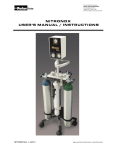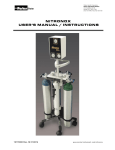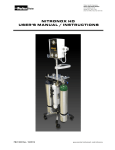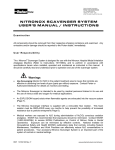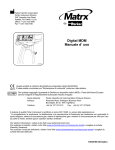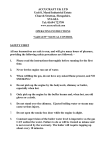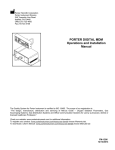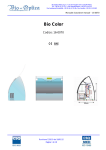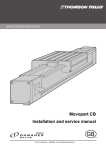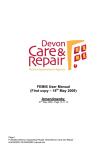Download Nitronox Scavenger System User Manual
Transcript
NITRONOX SCAVENGER SYSTEM USER’S MANUAL / INSTRUCTIONS Examination All components should be removed from their respective shipping containers and examined. Any omissions and/or damage should be reported to the Porter dealer, immediately. User Responsibility T h e Nitronox® Scavenger System is designed for use with the Nitronox Inhalation Analgesia System (Refer to Instructions 10115900), and to perform in accordance with specifications herein when installed, operated and maintained as instructed in this manual. It should be carefully read and understood prior to operation and use of the scavenger system. Warnings Use Scavenging Monitor for N2O in the patient treatment area to insure that controls are effective in achieving low levels of ppm (parts per million) exposure. Contact Porter or Authorized Distributor for details on monitors and testing. The Nitronox Scavenger System is intended to be used by medical personnel trained in its use and the use of nitrous oxide and oxygen for medical applications. An EXPLOSION hazard exists when flammable agents are exhausted into the vacuum system (Page 7). The Nitronox Scavenger interface is supplied with a removable flow resistor. This foam resistor must be REPLACED every six months to help prevent the possibility of increased resistance due to particle entrapment (Page 8). Medical workers are exposed to N2O during administration of N2O/O2 conscious sedation analgesia. NIOSH has recommended that exposures should be minimized. Contact NIOSH (1-800-35-NIOSH) to receive NIOSH Publications on Control of Nitrous Oxide in Dental Operatories. Exposure can be minimized by effective controls. National Institute for Occupational Safety and Health (NIOSH) publications state that controls, including System Maintenance, Ventilation and Work Practices can effectively reduce N2O concentrations in patient procedures. Your accessory Nitronox Scavenger System is an important part of the system of controls in medical settings. REF 10152100 Rev. G 1001/20143 www.porterinstrument.com/nitronox Manufacturer: Porter Instrument Division Parker Hannifin Corporation 245 Township Line Road Hatfield, PA 19440 Office 215 723 4000 Fax 215 723 5106 This product complies with the Medical Device Directive (93 / 42 / EEC). A “Declaration of Conformity” in accordance with the directive has been made and is on file. European Communities should contact the Authorized Representative listed below regarding any Medical Device Directive (MDD) inquiries. Contact Name: Mailing Address: Phone: Parker Hannifin Ltd Instrumentation Products Division Riverside Road, Pottington Business Park Barnstaple, EX 31 1NP, England +44 (0) 1271-313131 Fax: +44 (0) 1271-373636 The Quality System for Porter Instrument is certified to ISO 13485. The scope of our registration is: “The design, manufacture, distribution and servicing of Nitrous Oxide – Oxygen Sedation Flowmeters, Gas Scavenging Systems, Gas Distribution Systems and Office Communication Systems for use by a physician, dentist or licensed healthcare Profession.” Check our website: www.porterinstrument.com for additional information. To register your product: www.porterinstrument.com/resources-dental choose Warranty tab. To download a User’s Manual: www.porterinstrument.com/resources-dental choose Manuals tab Nitronox® Scavenger System - Description The Nitronox Scavenger System is a device for the removal of patient exhaled O2 / N2O gas mixtures generated from the Nitronox Inhalation Analgesia System. The exhaled gases are routed through the device to a remotely located central vacuum system. The Nitronox Scavenger and central vacuum systems provide dilution and disposal of mixed waste gases. The scavenger system consists of components necessary to transfer patient exhaled gas mixtures to the source of vacuum at the wall. Ambient opening (foam resistor) Fig. 1 Limit Orifice Drain Valve Fig. 1.1 Interface Fig. 1.2 Demand Valve Collection Manifold Fig. 1.3 Demand Valve Collection Manifold 19mm Hose Fig. 1.4 19mm Hose The system components are (Fig. 1): A COLLECTION MANIFOLD (Fig. 1.2) located at the exhaust ports of the Demand [breathing] Valve (Figs. 1.2, 1.3). A cylindrical INTERFACE (Fig. 1.1) to connect the central vacuum system with the scavenger collection manifold. It contains: o o o Orifices to limit vacuum pressure and flow. Opening to ambient to help prevent over/under pressurization of the patient exhaust circuit. A valve to automatically drain any internal condensation. The interface is connected to the rear of the support pole to the Hospital Nitronox unit. A corrugated 19mm hose (Fig. 1.4) to connect the collection manifold to the interface. 2 Nitronox® Scavenger System - Description The gas flow path through the scavenger system starts with patient exhalation into the exhaust ports of the demand valve and then to the collection manifold into the 19 mm scavenger hose. The hose leads the gas into the scavenger interface. The interface is open at the top to ambient via a calibrated foam resistor. In addition, the interface contains an internal pathway for gas passage permitting waste gas to follow a preferential path to wall vacuum. From the internal pathway of the interface, the waste gas flows through a ball-type control valve to a calibrated orifice contained within the barbed wall vacuum connector. The final gas path is through the DISS or QUICK connect vacuum hose to the wall vacuum outlet and the central vacuum pump system (or appropriate connections to a portable vacuum source). If central vacuum flow through the calibrated orifice exceeds the exhaled flow from the patient, room air will be drawn from ambient into the vacuum system via the scavenger interface. Also the internal volume of the interface acts as a surge chamber to absorb a short duration of excessive patient flow. During this short duration, excess gas will fill the interface allowing time for the vacuum flow to exhaust the gas during the next patient inspiration. Under abnormally large exhalations, it is possible that the excess exhaled gas may exceed the capacity of the interface chamber, and exhaust to ambient. This entrance and exit of gas to ambient is a feature operating only during transient unbalanced periods. Control of excess flow from the central vacuum through the orifice is provided by the ball control valve. The ball valve limits the central vacuum flow between an upper (maximum) and a lower (minimum) limit. No control other than the passive interface capacity and preferential flow path within the interface is provided for excess patient exhalation such as during a cough. An automatic relief valve is provided in the bottom of the interface to prevent condensation from causing a water seal of any internal gas passages. This is another feature operating only when condensation occurs. Installation Mobile Stand Mount Connect the cylindrical Nitronox Scavenger interface to the center column assembly of the Mobile Stand (Figs. 2.1, 2.2). Use the mounting clips of the interface to position the assembly on the column. Orient the interface assembly vertically with open end (foam resistor) up and condensation relief drain valve down. Fig. 2.1 3 Fig. 2.2 Full Face Mask Nitronox Main Housing Mixture Pressure Line Pressure Gages 19mm Hose Cylinder Pressure Gages E-Stand Block Ambient Opening Cylindrical Interface N2O Cylinder O2 Cylinder Drain Valve Fig. 3.1 E-Stand with 4 cylinders Installation Fig. 3.2 E-Stand with Nitronox & Scavenger Mobile E-Stand Mount The Porter Mobile E-Stand is for use with two “E” cylinders of O2 and two “E” cylinders of N2O (Figs. 3.1, 3.2). The two pressure gages reflect cylinder pressure only. When the gas supply is opened, gas will flow through the check valves into the block and be regulated down to 50 PSIG (3.4 bar) at the regulators, out through the hoses to the Nitronox. The check valves prevent the gas from flowing between cylinders or out into the room if only one cylinder is in use. Each Mobile Stand may be adjusted to a desired height for use and storage. Refer to FM-916 Mobile E-Stand Installation and Instructions for information on monthly checks, cylinder installation, height adjustment, check valve replacement. Connect the cylindrical INTERFACE to the center column assembly of the Mobile E-Stand. Use the mounting clips of the interface to position the assembly on the column. Orient the interface assembly vertically with ambient open end (foam resistor) up and condensation relief drain valve down. Position the interface between the four cylinder positions as shown in Fig. 3.1 (cylinders are closer together on opposite side). 4 Installation Wall Mount: Figs. 4, 5 1. Hold the scavenger interface against the wall in the desired mounting location. 2. Mark four mounting-hole locations on wall using the interface mounting plates as templates. 3. Drill four holes in the locations marked: Note: For dry wall or plaster, drill hole suitable for a screw attachment. For wooden studs, drill appropriate pilot hole, 1-1/2 inches (4 cm) deep to accept mounting screws. 4. Insert appropriate receptacle (not provided) in hole, if necessary. 5. Mount the scavenger interface using four screws (not provided) in the prepared locations (Fig. 2). Note: Mounting installation must be done on both the top and the bottom brackets. Fig. 4 Scavenger W all Mount F i g . 5 Nitronox Housing Wall Mount W ith Scavenger W all Mount 5 Collection Manifold: Figs. 6.1, 6.2 Push the collection manifold onto the plastic outlet housing of the demand valve until the o-rings seat and the manifold bottoms (Fig. 6.1). Turn the collection manifold 19 mm outlet port clockwise to be parallel with the delivery hose (Fig. 6.2). Fig. 6.1 Fig. 6.2 6 Hose Connections: Fig. 7 1. Connect the 19 mm scavenger hose between the 19 mm connectors on the collection manifold and the interface (Fig. 7.1). 2. Connect vacuum hose between the vacuum source inlet (using appropriate connection such as DISS, QUICK connect, etc.) and the barbed outlet connector on the interface. Push the tubing on the barb so that two to three barbs are covered. Note: Hold the barbed outlet while pushing tubing onto barb to reduce excess strain. 19mm Hose Connection Fig. 7.1 Barbed Outlet Connection Fig. 7 Warning An EXPLOSION hazard exists when flammable agents are exhausted into the central vacuum system. 7 Operation 1. Connect wall or Mobile E-Stand gas supplies – O2 and N2O. Connect vacuum source to Nitronox Scavenger barb. 2. Adjust the position of the collection manifold by rotating clockwise so that the hoses lie in a parallel position (Fig. 8). Secure the delivery hose and the 19 mm scavenger hose together using the five tie wraps (or hook and loop) supplied (Fig. 9, 9.1) (see Corrugated Scavenger Hose Assembly Instructions FM-1236). Space the tie wraps (or hook and loop) equally starting at the demand valve and working back to the scavenger interface. Fig. 8 Fig. 9.1 Fig. 9 3. For best scavenging vacuum flow, turn the ball valve lever to the vertical (full on position) (Fig. 10). Note: With the ball valve lever in the full on position, the vacuum flow should accommodate the exhaust gas from all normal breathing patterns (30 – 35 LPM, maximum). Fig. 10 4. If the overall demand for vacuum is overloading the central system, the ball valve may be slightly throttled to reduce vacuum flow by turning the ball lever to the 45º from vertical position. Note: With the lever in the 45º from vertical position, the ball valve will still allow a vacuum flow of 8 to 12 LPM, minimum. 5. The interface is designed so that condensed water vapor should discharge from the bottom, if its volume exceeds 40 to 50 cc/mL. 8 Maintenance Cleaning We recommend the use of an approved disinfectant for the dental / medical environment for cleaning the outside of the Nitronox Scavenger System. (See Nitronox User’s Manual / Instructions 10115900 for special demand valve cleaning instructions). Do not spray disinfectant directly onto housing. Spray disinfectant into disposable towel and wipe unit thoroughly removing excess disinfectant to eliminate buildup. CAUTION: Introduction of moisture or other contaminants into this device may result in defective operation. CAUTION: Never oil or grease any part of this system (minimize fire or explosion potential). Field Replacement 1. Replacement of the foam flow resistor PN 61962300 (refer to Figure 1.1) approximately every six months and periodic replacement of the Scavenger Hose Assembly. Warning The foam flow resistor is to be replaced approximately every 6 months to help prevent the possibility of increased resistance due to particle entrapment. 2. Pull the foam resistor (one inch, diameter, by six inches, long) from the top center hole of the interface cylinder with the use of forceps or needle nose pliers. 3. Using a 12-inch long (30 cm), stiff strip of music wire (or equivalent), insert a new foam resistor into the interface top-center hole until the top of the foam resistor reaches the lower edge of the horizontal vent holes. 4. Remove the wire, holding top of the foam resistor with the forceps or needle nose pliers. Replacement Parts: Contact Porter 9 Specifications Note: Porter may apply technical advances whenever it is desirable. Specifications are subject to change WITHOUT NOTICE. Porter should be contacted for current information. Materials of Construction - Plastics:ABS, PVC, Polyethylene, Nylon, Natural Latex Rubber (flutter valve; does not come in contact with patient). Dimensions: Collection Manifold Interface Scavenger Hose (19 mm) Vacuum Hose (not supplied) Diameter Length 2-1/4” (5.7 cm) 2-1/2” (6.4 cm) 19 mm, ID 3/8” (9.5 mm), ID 1” (2.5 cm) 20” (50.8 cm) 60” (152 cm) As Required Vacuum Source: -14” to -21” Hg (-356 mm to -533 mm Hg) 2.0 to 3.5 SCFM (56.6 to 100 LPM) Pressure Flow Interface Flow: Ball Valve Full Vertical (Max. Flow) 30 – 35 LPM Ball Valve 45º Position (Min. Flow) 8 – 12 LPM Relief Valve (Condensation): Relief Volume Retention Volume 40 – 50 cc/mL 5 – 10 cc/mL Ambient Temperature Limits: Minimum 40ºF (5ºC) Maximum 140ºF (60ºC) 10 CERTIFICATE OF WARRANTY THIS W ARRANTY IS GIVEN IN PLACE OF ALL OTHER W ARRANTIES, EXPRESS OR IMPLIED, OF MERCHANTABILITY, FITNESS FOR A PARTICULAR PURPOSE O R OT H ERW ISE. Under no circumstances shall Parker Hannifin Corporation be liable for incidental or consequential damages as those terms are defined in the uniform commercial code. Parker Hannifin Corporation, Porter Instrument Division warrants that each product or part shall be free from defects in workmanship and materials, under normal use and with appropriate maintenance, for one (1) year from the date of delivery to customer unless otherwise specified in writing. All rubber and plastic parts and accessories are warranted under the same conditions for a period of ninety (90) days from date of purchase. No statement or claim about the product by any employee, agent, representative, or dealer of Parker Hannifin Corporation shall constitute a warranty by Parker Hannifin Corporation or give to rise to any liability or obligation of Parker Hannifin Corporation. Parker Hannifin Corporation shall not be liable for any damage, injury or loss arising out of the use of the product, whether as a result of a defect in the product or otherwise, if, prior to such damage, injury or loss, the product was (1) damaged or misused; (2) repaired, altered or modified by persons other than Parker Hannifin Corporation; (3) not installed in strict compliance with applicable codes and ordinances; or (4) not installed by an authorized Parker Hannifin Corporation dealer. Parker Hannifin Corporation's obligation for breach of this warranty, or for negligence or otherwise, shall be strictly and exclusively limited to the repair or replacement of the product or part. This warranty shall be void on any product on which the serial number has been altered, defaced or removed. ORDERS All orders are to be made through authorized Parker Hannifin Corporation distributors. All billing will be done through said distributors. Direct orders will be handled through the authorized local dealer as determined by Parker Hannifin Corporation. RETURNS All returned merchandise will be handled through the local Parker Hannifin Corporation distributor. No returns will be accepted unless authorized in writing by Parker Hannifin Corporation and accompanied by the original shipping invoice. All returns are subject to restocking charge. Policies subject to change without notice. T he Q ua l i t y S ys t em f or P or ter is c e rt if i e d t o I SO 1 34 8 5. T he s c o pe of o ur r eg is tra t io n is : T h e d es i gn , m an uf ac t ur e, d is tr i b ut i on an d s er v ic i n g of N i tr ous O x i d e - O x yg e n S ed at i o n F l o w M et er s , G as Sc a v e ng i n g S ys tem s , S t eam S ter i l i z ers , G as D is tr i b ut i on an d O f f ic e C om m uni c at i on S ys tem s f or us e b y a p h ys ic i a n, de nt is t or l ic e ns e d he a lt hc ar e pr of es s io n a l. 11 REVISION HISTORY REV. DATE ECO # DESCRIPTION OF CHANGES DR E 1/3/13 ECO0033627 First release from Porter after acquisition of product line from Schein Added Parker Porter branding on Cover Page Removed Matrx from illustrations Added new photo illustrations Illustration Page 6: Changed “Caution” to “Warning” “Explosion hazard …” [consistent with Cover and Page 7 Warning] Removed numbers from Replacement Parts page 9 Replaced Matrx Warranty information with Porter Warranty, page 10 Added Porter ISO 13485 scope statement, page 10 SDL F 1/31/13 ECO0034133 SDL G 01/17/2014 Added picture of Scavenger Wall Mount and Nitronox Housing Wall Mount on Page 5. Corrected Vacuum Hose size on Page 9: 3/8” (9.5 mm) ID was ¼” (6.4 mm) ID. Added Fig. numbers and describing text. Standardized “Nitronox Scavenger System” and “Nitronox Inhalation Analgesia System”; added revision date on front page; Standardized “EStand”; changed polypropylene to polyethylene; added Cleaning methods / Field Replacement; New Fig. 9; removed recommendation for glutaraldehyde. DATE: 1/3/13 ECO-0033627 DR: SDL Nitronox Scavenger System Instruction Manual CH SDL Page 12 of 12 NUMBER: 10152100 REV. 10152100 G APPR













